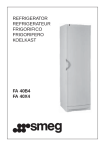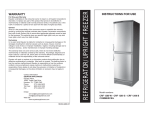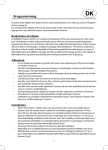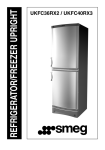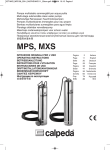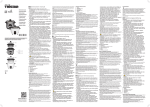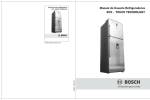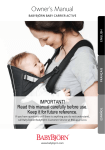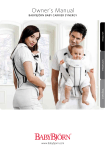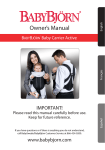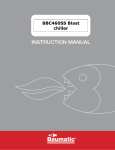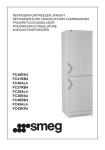Download Smeg CV35XS4 Owner's Manual
Transcript
FREEZER UPRIGHT CONGELATEURS CONGELADOR CONGELATORE DIEPVRIEZER CV35BS4 CV35XS4 Please read these instructions carefully before putting the appliance into service. They are brief and contain only information which will help you to obtain the best performance from the appliance. Take care of all accessories supplied with the appliance. Il est important de lire attentivement le mode d’emploi avant d’utiliser votre appareil. Il contient des informations très utiles pour obtenir les meilleures performances possibles et assurer un fonctionnement parfait de votre appareil. Prenez soin de tous les accessoires fournis avec votre appareil. Antes de usar su nuevo congelador, debe leer cuidadosamente todas las instrucciones contenidas en este folleto. Contiene solamente las informaciones necesarias para que Vd. puede tener el máximo rendimiento de su nuevo electrodoméstico. Tenga cuidado de guardar todos los accesorios del aparato en un lugar adecuado. Prima di utilizzare l’apparecchio vogliate leggere attentamente e per intero il libretto con le istruzioni d’utilizzo al fine di sfruttare al meglio le caratteristiche del prodotto. Conservate questo documento insieme agli accessori in dotazione all’apparecchio. Het is belangrijk deze gebruiksaanwijzing aandachtig te lezen alvorens uw toestel in werking te stellen. Ze bevat belangrijke informatie die u zal helpen uw toestel optimaal en probleemloos te gebruiken. 2 GB ............................................................... 4 F .................................................................. 7 E ................................................................ 10 I ................................................................. 13 NL ............................................................. 16 3 CONTENTS 1. Before starting the refrigerator/freezer. 2. How to use the appliance. 3. General advice on the use of the appliance. 4. Maintenance. 5. Has the appliance stopped working? 6. Safety. 7. Technical data. 8. Installation. 9. Change of hinge side. 1. BEFORE STARTING THE FREEZER Check that the cabinet is undamaged. Please report any transport damage immediately to your dealer. Wash the cabinet and inner lining with a mild unscented detergent and wipe it dry. Do not use abrasive scouring powder, steel wool or similar. Connection to the electricity supply: See head (7) and (8). 2. HOW TO USE THE APPLIANCE Operating panel: See fig. (1) page 21. 1. Lamp. 2. Thermostat knob. 3 Indicator for the connection to the electricity supply (green). 4. Indicator for deep-freezing (yellow). 5. Button for deep-freezing. 6. Thermometer. 7. Warning lamp. The thermostat knob is adjustable from 0 (stop) to 7 (coldest). Find the position of the thermostat which gives you the desired temperature. Start at position 4. Operating panel. See fig. (1) page 21. Deep-freezing: Push the button (5). The yellow indicator will then glow. It stops glowing when the button is pushed anew. When the quantity of foodstuffs to be frozen is larger than 3 kg the button for deepfreezing should be pushed about 24 hours before the desired freezing. The button is pushed anew when the foodstuffs are frozen. It is important that the deep-freezing takes 4 place as quickly as possible. Therefore, the temperature of the foodstuffs should be no higher than room temperature. Otherwise follow the advice given in handbooks on deep-freezing and the choice of packing material. Place the foodstuffs so that they obtain maximum contact with the freezing shelf. Open the door only when necessary. The lamp of the alarm knob, fig. (1). page 21, indicates whether the acoustic alarm is on. If the lamp is lit the acoustic alarm will sound if the temperature is too high. Please note that the water ices, if consumed immediately after removal from the freezer compartment may result in a freezer-burn, and they should be allowed to warm slightly before consumption. Defrosting The foodstuffs cause frost to be formed. A thin layer of frost does not affect the performance of the freezer. Loose frost may be removed carefully with a plastic or wooden scraper. Never use a knife or other sharp tools. When the layer of frost on the shelves is 5-10 mm the freezer should be defrosted. Note: The layer of frost on the front edge of the top freezing shelf may grow slightly thicker. Do like this: Switch off the freezer. Take out the foodstuffs and wrap them in newspaper, a blanket or similar and store them as cold as possible. Place a bowl with hot but not boiling water in the freezer. Fold out the draining spout, mount the enclosed extension and place a bowl under it, fig. (3) page 21. Wipe the cabinet when the frost has disappeared. 3. GENERAL ADVICE ON THE USE OF THE APPLIANCE The freezing shelf cover should be closed. The covers are opened by pulling, fig. (6) page 21. To remove the baskets lift them over the stop pins, fig. (4) page 21. If the cabinet is not to be used for more than 48 hours the doors should be left open to avoid ill smells. The appliance is equipped with a high-quality skin condenser. Therefore, a slight heating of the sidewalls is quite normal. Lighting This appliance is equipped with a device which causes the light to switch off if the door is open / left ajar for abnormally long time. When the door has been closed for a couple of minutes, the device is cut off and the light switches on in normal way again. Important! In case of damage to the power cord it must be replaced by a power cord of corresponding type, available from the manufacturer or his service representative. frost has formed on the evaporator. Do not open the cabinet when unnecessary. If the break appears to stretch over a longer period (over 12 hours) store the foodstuffs, if possible, in another freezer. Most foodstuffs, if thawed on the outside but otherwise hard, can be re-frozen. 6. SAFETY Scrapped cabinets may become dangerous to children at play. Therefore, remove the doors or place the scrapped cabinet in such a way that children cannot enter it. Never store liquids with carbon dioxide in the freezer. 7. TECHNICAL DATA This appliance meets the provisions of the following directives: 89/336/EEC (electromagnetic compatibility), 73/23/EEC (electrical equipment designed for use within certain voltage limits) as amended. Household appliances sold in the EU also meet 96/57/EEC (energy efficiency requirements) as amended. The rating plate, which is placed either at the back or inside the appliance, see fig. (7) page 21, provides various technical information as well as type and serial number. 4. MAINTENANCE Only use an unscented detergent when cleaning the cabinet inside. Switch off the appliance and pull out the plug when cleaning the cabinet. The skirting board can be removed to faciliate a vacuum cleaning of the floor. See fig. (1) page 20. 5. HAS THE APPLIANCE STOPPED WORKING? Before calling a repairman, check that the plug is properly plugged into the wall socket. The fuse is intact. The power has not been cut off. All controls are correctly set. The quantity of foodstuffs in deepfreezing is not too large. Switch off the cabinet for 15 minutes (for instance at the thermostat). Switch it on again and after 5 minutes check whether 8. INSTALLATION See drawings (1) and (2) page 20. Install the cabinet in a dry place and so that it is not exposed to direct sunlight or any other source of heat. Place the cabinet in a level position. This is easily achieved by adjusting the adjustable feet at the front edge of the base. The cabinet should not rest against a wall on its hinged side. When placing the cabinet on a carpet or on a wooden floor, the placing should be checked after a while to see whether the unit has „subsided“ into the soft flooring. The Cabinets can be built in or put side by side, see fig. (2) page 20. For sufficient airflow around the cabinet it is necessary to have a 50 mm high air duct right above the appliance, see fig. (2), an air duct that leeds the air up over the top cupboard. Make sufficient space for door opening as to draw the baskets out, see fig. (2). 5 The dimensions for building in are noted on the drawings. It is safest to place the earthed wall socket above the appliance and at least 2.0 m above the floor. Any local installation rules for appliances of this kind must be observed. During a storm the electricity supply might be cut off. You should be aware of this when installing the appliance in weekend cottages or elsewhere where you would not immediately observe that the power has been cut off. Construction and details in the accessories are subject to alteration without previous notice. If the cabinet is to be adjusted: See drawings (1) page 20. Take hold of the front panel with both hands. Then lift up the front panel and turn out the bottom part. 9. CHANGE OF HINGE SIDE See drawings page 22. 1) Dismantle the top hinge. This one is to be used later as top hinge at the opposite side. Lift off the top door. 2) Remove the kick panel. The bottom hinge is dismounted at the 3 screws. The hinge is turned 180° and mounted on the opposite side. 3) Adjusting the bottom door: Loosen the 3 screws in the bottom hinge and push the bottom hinge to the required side. Tighten the screws and mount the kick panel. 4) The kick panel is mounted and the hole plugs are mounted on the opposite side. 5) Ajustment of the top door: loosen the screws in the hinge above the door, loosen the hinge above the door and turn the hinge to the wanted side. Tighten the screws. 6) Move the handle. Adjust the tilt of the unit See drawings (1) page 20. by turning the adjustable feet with a 13 mm spanner. Adjusting the door See drawings (1) page 20. If the door bumps against the bottom panel, this can be remedied by adjusting the feet as shown on the drawing. DISPOSAL OF THE APPLIANCE The appliance contains recyclable materials. When disposing of the appliance, please contact the technical administration or other appropriate authority in your municipality. They can inform you of the collection and recycling measures used in the municipality. 6 CONTENU 1. 2. 3. 4. 5. 6. 7. 8. 9. Avant la mise en service. Comment utiliser votre appareil. Conseils. Entretien. En cas de panne. Sécurité. Informations techniques. Instructions d’installation. Changement du sens d’ouverture des portes. 1. AVANT LA MISE EN SERVICE Avant la mise en service de votre appareil il est conseillé de vérifier s’il n’a subi aucun dommage pendant le transport. En cas de dommage, avertissez immédiatement votre revendeur. Nettoyez les parois intérieures et extérieures avec de l’eau et un détergent neutre et inodore, séchez-les ensuite. N’employez jamais de produits abrasifs ou de la laine de fer. Nous référons aux chapitres (7) et (8) pour la connexion au réseau électrique. 2. COMMENT UTILISER VOTRE APPAREIL Panneau de commande : voir fig. (1) page 21. 1. lampe 2. thermostat 3. voyant vert : appareil sous tension 4. voyant jaune : congélation 5. touche congélation 6. thermomètre 7. voyant alarme Le thermostat est réglable de la position 0 (stop) à 7 (position la plus froide). Réglez la température désirée à l’aide du thermostat en commençant à partir de la position 4. Pour le panneau de commande voir fig. (1) page 21. Pour la congélation pressez le bouton (6), le voyant lumineux jaune s’allumera. Si vous pressez à nouveau, le voyant s’éteindra. Lorsque vous désirez congeler une quantité supérieure à 3 kg, pressez le bouton 24 heures à l’avance. Quant les aliments sont totalement congelés, pressez à nouveau le bouton. Il est important que les aliments soient congelés le plus rapidement possible jusqu’en leur centre. C’est pour cette raison que la température des aliments à congeler ne devrait pas dépasser la température ambiante. Il est utile de suivre les conseils donnés dans des livres au sujet de la congélation et le choix du matériel d’emballage. Tâchez que les aliments touchent au maximum la surface de la clayette. Ouvrez la porte que si nécessaire. Le voyant de l’alarme fig. (1) page 21 indique que le signal sonore est branché. Si le voyant est allumé l’alarme s’enclenchera lorsque la température est trop élevée. Ne consumez jamais les glaces et les glaçons à la sortie du congélateur. La température basse risquerait de provoquer des brûlures dues au froid sur les lèvres. Dégivrage Une fine couche de givre ne peut entraver le bon fonctionnement de votre appareil. Le givre poudreux peut être dégagé à l’aide d’une spatule en bois ou en plastic. N’employez jamais de couteaux ou d’autres objets tranchants. Dégivrez votre appareil lorsque la couche de givre a atteint 5 à 10 mm. Note : la couche de givre sur la partie avant de la clayette supérieure peut devenir plus épaisse. Pour lancer la procédure de dégivrage éteignez le congélateur. Enveloppez les aliments dans plusieurs couches de papier journal ou une couverture et rangez-les dans un endroit frais. Placez des récipients d’eau chaude à l’intérieur du congélateur. Attention : ne pas employer de l’eau bouillante. Dégagez le tube d’écoulement, montez la rallonge et placez un récipient en-dessous fig. (3) page 21. Séchez soigneusement l’intérieur. 7 3. CONSEILS Contrôlez que la porte du compartiment congélation soit fermée. La porte est rabattable fig. (6) page 21. Pour enlever les paniers, tirez-les vers vous et soulevez-les au-dessus des arrêts fig. (4) page 21. Si vous n’utilisez pas votre appareil pendant plus de 48 heures il est conseillé de laisser la porte entrouverte afin d’éviter les mauvaises odeurs. L’appareil est équipé d’un condensateur intégré. Un léger réchauffement des parois latérales est tout à fait normal. L’éclairage intérieur Cet appareil est équipé d’un système qui éteint la lumière dès que la porte reste ouverte pour une durée anormalement longue. Lorsque vous refermez la porte pour quelques minutes, le système est débranché et la lumière s’allume à nouveau normalement. Important ! Si le câble d’alimentation est endommagé, il faut le remplacer par un câble du même type. Ce câble est disponible chez votre revendeur. 4. ENTRETIEN Utilisez seulement un détergent inodore pour nettoyer les parois intérieures de votre appareil. Avant de procéder au nettoyage nous vous recommandons d’éteindre votre appareil et de retirer la fiche d’alimentation de la prise de courant. La plinthe peut être retirée afin de faciliter le nettoyage du sol. Voir fig. (1) page 20. 5. EN CAS DE PANNE Avant de faire appel à un technicien, vérifiez : - si la fiche est bien branchée dans la prise - si le fusible n’a pas sauté - si la température a été réglée correctement - si la quantité d’aliments à congeler n’est pas trop importante Débranchez l’appareil pendant 15 minutes 8 (par exemple à l’aide du thermostat). Remettez l’appareil en marche et vérifiez après 5 minutes s’il y a formation de givre sur l’évaporateur. N’ouvrez pas la porte de votre appareil si ce n’est pas nécessaire. Si la panne dure plus de 12 heures il faut ranger les aliments si possible dans un autre congélateur. La plupart des aliments dégelés à l’extérieur mais encore durs peuvent être recongelés. 6. SECURITE Si vous mettez au rebut votre ancien appareil, nous vous conseillons d’enlever la porte ou de placer l’appareil de manière à ce que les enfants ne puissent s’y enfermer. Ne conservez pas de produits à base de dioxyde de carbone dans votre congélateur. 7. SPECIFICATIONS TECHNIQUES Cet appareil correspond aux normes des directives suivantes : 89/336/EEC, 73/23/ EEC Les appareils vendus en Union Européenne correspondent aux normes :96/57 EEC La plaquette signalétique, qui est située au dos ainsi qu’à l’intérieur de l’appareil fig.(7) page 21 vous donne différentes informations techniques, ainsi que le type et le numéro de série de l’appareil. 8. INSTRUCTIONS D’INSTALLATION Voir dessins (1) et (2) page 20. Installez votre appareil dans un endroit sec à l’abri des rayons de soleil ou autre source de chaleur. Placez votre appareil à niveau en réglant les pieds avant de l’appareil. Ne pas placer le côté des charnières contre un mur. Si vous installez votre appareil sur un tapis ou une surface en bois, nous vous conseillons de vérifier si l’appareil ne s’enfonce pas dans le revêtement. Votre appareil peut être encastré ou placé côte à côte. Voir fig. (2) page 20. Afin d’avoir une circulation d’air suffisante autour de l’appareil il est nécessaire de garder un espace de 50 mm au-dessus de l’appareil. Voir fig. (2) Ou d’avoir un espace au-dessus de l’armoire du dessus afin que l’air puisse circuler librement. Tâchez d’avoir suffisamment de place pour ouvrir la porte afin de pouvoir retirer aisément les paniers. Voir fig . (2) Nous référons aux dessins pour les dimensions d’encastrement. Pour votre sécurité nous vous conseillons de placer une prise de courant muni d’une terre à 2 m du sol. Il est nécessaire de tenir compte des règlementations locales de sécurité. Pendant un orage ou une tempête il peut y avoir une rupture de courant. Il est nécessaire d’en tenir compte lorsque l’appareil est placé dans une maison de vacances ou tout autre endroit où l’on ne remarquerait pas directement qu’il y a eu une rupture de courant. Toutes les spécifications peuvent être soumises à des modifications sans avis au préalable. 9. CHANGEMENT DU SENS D’OUVERTURE DES PORTES 1) Enlevez la charnière du dessus. Celle-ci devra servir au côté opposé. Soulevez la porte supérieure. 2) Retirez la plinthe. Dévissez les trois vis de la charnière inférieure. Tournez la charnière à 180 ° et placez-la au côté opposé. 3) Ajustez la porte inférieure : dévissez les 3 vis de la charnière inférieure et poussez la charnière du côté opposé. Serrez les vis. 4) Placez les plugs de la plinthe au côté opposé et replacez la pinthe. 5) Ajustez la porte supérieure : dévissez les vis de la charnière au-dessus de la porte et tournez la charnière dans le sens désiré. Serrez les vis. 6) Déplacez la poignée. Placez votre appareil à niveau: Voir dessin (1) page 20 Tirez la plinthe avec vos deux mains vers le haut et rabattez-la . Réglez les pieds Voir dessin (1) page 20 Placez votre appareil à niveau en tournant les pieds réglables à l’avant de l’appareil à l’aide d’une clé de 13 mm. Votre appareil contient des matériaux recyclables. Nous vous recommandons de prendre contact avec les autorités locales pour obtenir des informations et la listes des centres de collecte de déchets. 9 INDICE 1. 2. 3. 4. 5. 6. 7. 8. 9. Instalación. Cuadro de mandos y su utilización. Algunos consejos para el uso diario. Entretenimiento. Lista de chequeo en caso de malfunción. Consejos de seguridad. Datos técnicos. Instalación eléctrica y alineamiento. Cambio del sentido de apertura de las puertas. 1. INSTALACION E INSPECCION Examinar cuidadosamente el aparato de posibles daños de transporte. En caso de daño, informar inmediatamente al distribuidor. Limpiar todo el aparato por dentro y fuera en agua tibia con un poco de detergente suave y no perfumado. Evitar el uso de detergentes abrasivos, lana de acero etc. lnstalación eléctrica: Ver los puntos 7 y 8. 2. CUADRO DE MANDOS Y SU UTILIZACION Cuadro de mandos, fig. (1), pág. 21: 1. Iluminación. 2. Mando de temperatura. 3. Piloto de conexión a la red eléctrica (verde). 4. Piloto indicador de congelación rápida (amarillo). 5. Interruptor de congelación rápida. 6. Termómetro. 7. Lámpara de alarma. El mando de temperatura puede regularse desde 0 (paro) a 7 (frío máximo). Elije la posición más adecuada de los mando para obtener la temperatura deseada, empezando con “4”. Cuadro de mandos: Ver fig. (1) pág. 21 Congelaclón rápida: Pulsando el interruptor (5), el piloto (4) se enciende, apagandose pulsando otra vez el interruptor. Debe iniciarse la congelación rápida pulsando el interruptor (5) aproximadamente 24 horas antes de colocar los alimentos si se trata de cantidades superiores a 3 kilos. Cuando los alimentos se hayan congelado 10 completamente, desactivar la congelación rápida pulsando el interruptor de nuevo. Para evitar un período prolongado de congelación los alimentos deben tener a temperatura de ambiente. Existen manuales útiles que contienen consejos adicionales sobre la congelación y selección del tipo de embalaje adecuado. Los alimentos deben colocarse de tal manera que tengan el máximo de contacto con la bandeja evaporadora. No abrir la puerta del congelador salvo en caso necesario. La bombilla del botón de la alarma fig. (1) pág. 21 indica si la alarma acústica está encendida. Si Ia bombilla está encendida, la alarma acústica sonará si la temperatura es demasiado alta. Polos helados pueden causar quemaduras de helada si son consumidos directamente de la sección congeladora. Deja calentarse un poco antes de la consumición. Desescarchamiento Los productos y alimentos causan la formación de escarcha. Sin embargo, una capa reducida de escarcha o hielo no influye en el funcionamiento correcto del congelador. Las escarchas sueltas pueden removerse con mucho cuidado usando una rasqueta de plástico o madera. Nunca emplear cuchillas u otros objetos cortantes. Debe efectuarse el desescarchamiento cuando la capa de escarcha o hielo en los estantes tenga un espesor de 5-10 mm. Nota: La capa de escarcha puede tener algo más de espesor en la parte delantera de la bandeja superior. 1. Desconectar el aparato. 2. Sacar todos los productos congelados del aparato, envolverlos en periódicos, una manta o similar y ponerlos en un sitio frío. 3. Colocar un recipiente con agua muy caliente en el congelador. 4. Extender el pitón de desagüe montar la pieza de prolongación incluida y colocar un recipiente por debajo, fig. (3), pág. 21. 5. Cuando se haya fundido toda la escarcha, secar el aparato por dentro con un paño húmedo con un poco de detergente suave. 3. ALGUNOS CONSEJOS PARA EL USO DIARIO La tapa del compartimento de congelación rápida debe permanecer cerrada. Las tapas se abren tirandolas, fig. (6), pág. 21. Para sacar completamente los cajones, fig. (4), pág. 21, elevarlos para poder pasar el tope. Durante un periodo de parada de más de 48 horas debe abrirse un poco las puertas para evitar la formación de malos olores. El aparato lleva incorporado en las paredes un condensador de caparazón de gran calidad. Por lo tanto, el calor que se saque de compartimento interior y los productos almacenados pasa a radiarse a través de las paredes laterales del aparato, las cuales deben encontrarse algo calientes. 5. Que no se haya introducido un volumen de productos demasiado grande en el congelador. 6. Desconectar el aparato (en el mando de temperatura) durante 15 min. Conectar el aparato de nuevo y verificar después de 5 min. si se haya formado escarcha en el evaporador. 7. No abrir las puertas del aparato salvo en casos realmente necesarios. Si es probable que el periodo de malfunclón será superior a 12 h., intentar (si es posible) transferir los productos a otro aparato. La mayoría de productos que estén descongelados únicamente en la superficie, pero todavía duros, pueden volver a congelarse. Iluminación Este aparato es equipado con un dispositivo que hace que se apague la luz si la puerta está abierta/entreabierta durante mucho tiempo. Cuando la puerta ha sido cerrada unos minutos el dispositivo se desconecta y la luz se enciende de modo normal nuevamente. 6. CONSEJOS DE SEGURIDAD ¡Importante! En caso de dañar la línea de conexión a la red, ésta debe cambiarse con un tipo parecido suministrado por el fabricante o el representante de servicio. La limpieza del interior del aparato debe hacerse con agua y un detergente suave. Durante la limpieza debe desconectarse el aparato. Para facilitar la limpieza por debajo del aparato puede desmontarse el zócalo, fig. (1), pág. 20. Este aparato cumple las disposiciones de las directivas siguientes: la directiva EMC (89/336) y la directiva de tensión baja (73/23) y sus suplementos siguientes. Los aparatos domésticos vendidos dentro de la UE cumplen también la directiva de eficacia de energía (96/57) y sus suplementos siguientes. La etiqueta de características situada en el posterior del aparto o en su interior (ver fig. (7), pág. 21), contiene varias informaciones técnicas además de los números de identificación de serie y tipo. 5. LISTA DE CHEQUEO EN CASO DE MALFUNCION 8. INSTALACION ELECTRICA Y ALINEAMIENTO Antes de llamar el Servicio Técnico, checar los puntos siguientes: 1. Que la clavija esté bien enchufada. 2. Que el fusible no se haya quemado. 3. Que haya corriente eléctrica en su casa. 4. Que el panel de mandos esté ajustado correctamente. Ver los dibujos (1) y (2), pág. 20. El aparato debe colocarse en un sitio seco y de manera que no esté expuesto directamente a la luz solar u otra fuente de calor. El aparato debe instalarse en posición absolutamente vertical mediante las patas 4. ENTRETENIMIENTO Los aparatos desechados pueden ser peligrosos para los niños. Elimina el peligro quitando las puertas o colocando el aparato fuera del alcance de los ninos. No colocar botellas conteniendo hidrato de carbono en el congelador. 7. DATOS TECNICOS 11 ajustables por debajo de las puertas. En el lado de las bisagras no debe rozar el muro. En el caso de instalar el aparato en suelo moquetado o de madera, debe efectuarse un reajuste después de cierto tiempo para compensar para el hundimiento. El aparato puede empotrarse o combinarse con otro aparato, ver fig. (2), pág. 20. Para asegurar una circulación del aire alrededor del aparato hace falta tener un canal de ventilación de 50 mm de altura sobre el aparato, ver fig. (2) o un canal de ventilación dirigiendo el aire sobre el armario superior, ver fig. (2). Dar lugar suficiente a la abertura de la puerta para poder sacar los cajones, ver. fig. (2e). De los dibujos puede verse las medidas correctas para empotrar el aparato. El enchufe se coloca más fácilmente por arriba del aparato, a 2 metros del suelo. Respete siempre la legislación local para la instalación del aparato. El corriente eléctrico puede cortarse durante las tormentas. Debe notarse bien ésto cuando el aparato se instale en casas de campo u otros lugares donde no se puede vigilar diariamente. Se reserva el derecho de cambiar la construcción y detalles de acabado sin previo aviso. Ajuste el armario si es necesario Fig. (1), pág. 20. Oprime el panel debajo de la puerta para sacarlo. Ahora pueden ajustarse las patas. Ajuste la inclinación del armario Fig. (1), pág. 20. Por medio de girar las patas ajustables con una llave fija de 13 mm. Ajuste de la puerta Fig. (1), pág. 20. Si la puerta topa con el zócalo esto puede ser remediado regulando las patas como presentado en el dibujo. 12 9. CAMBIO DEL SENTIDO DE APERTURA DE LAS PUERTAS Pág. 22. 1) Desmontar la bisagra superior, la cual se utilizará posteriormente como bisagra superior en el lado opuesto. Levantar la puerta superior. 2) Saque el rodapié. Desmonte la bisagra inferior con los 3 tornillos, gire la bisagra 180º y montela en el lado opuesto. 3) Ajuste de la puerta inferior. Afloje los tres tornillos de la bisagra inferior y empuje la bisagra inferior al lado deseado. Fijen los tornillos y monte la rodapié. 4) Monte la rodapié y los tapones ciegos en el lado opuesto. 5) Ajuste de la puerta superior. Afloje los tornillos de la bisagra sobre la puerta y gire la bisagra al lado deseado. Tiense los tornillos. 6) Mueva la manija. Monte los tapones de cubierta de los hoyos de manija. INDICE 1. Prima di collegare il congelatore. 2. Utilizzo del congelatore. 3. Consigli generali per l’utilizzo del congelatore. 4. Pulizia e manutenzione 5. In caso di guasto. 6. Sicurezza. 7. Caratteristiche tecniche. 8. Installazione. 9. Reversibilità Incernieramento porta. 1. PRIMA DI COLLEGARE IL CONGELATORE Verificate che l’apparecchio sia in buono stato. Gli eventuali danni causati dal trasporto dovranno essere immediatamente segnalati al rivenditore. Lavare le pareti esterne ed interne dell’apparecchio con un prodotto per i piatti delicato e non profumato, poi asciugare. Non utilizzate dei prodotti abrasivi come ad es. pagliette o altro che potrebbero rigare le superfici. Per quanto riguarda il collegamento elettrico, vedere i punti (7) e (8). 2. UTILIZZO DEL CONGELATORE Frontalino comandi fig. (1) pag. 21. 1. Illuminazione interna. 2. Manopola termostato. 3. Spia luminosa del collegamento elettrico (verde). 4. Spia luminosa di congelamento rapido (gialla). 5. Pulsante di congelamento rapido. 6. Termometro. 7. Spia rossa d’allarme (si accende durante la partenza). La manopola del termostato è regolabile da 0 (spegnimento) a 7 (freddo max.) Procedere per tentativi al fine di trovare la posizione del termostato alla temperatura voluta. Partire in posizione 4, che in genere è sufficiente per far funzionare il congelatore in condizioni normali. Regolate anche la temperatura in base alla frequenza di apertura delle porte e dell’ubicazione dell’apparecchio. Fabella comand, vedere fig. (1) pag. 21. Congelamento: premere il pulsante (5). La spia luminosa (4) si accende. Si spegnerà solo in seguito ad una successiva pressione sul pulsante. Se le quantità da congelare sono superiori ai 3 kg, bisogna premere il pulsante di congelamento (5) 24 ore prima di introdurre gli alimenti. Premere nuovamente il pulsante quando gli alimenti saranno congelati. E’ importante che il congelamento si effettui il più rapidamente possibile. La porta non deve mai essere aperta più del necessario. La spia luminosa d’allarme può accendersi durante il congelamento degli alimenti e questo è normale. Si spegnerà quando gli alimenti saranno perfettamente congelati. Sbrinamento La presenza di alimenti provoca la formazione di brina. Uno strato sottile di brina o di ghiaccio non comporta un calo di rendimento del congelatore. La brina polverosa può essere grattata con cautela con una spatola in legno o in plastica. Non utilizzate mai coltelli o altri oggetti appuntiti o taglienti. Quando lo strato di brina di un ripiano raggiunge dai 5 ai 10 mm. di spessore, il congelatore deve essere sbrinato. N.B. Lo strato di brina che si forma sul bordo anteriore del ripiano superiore può essere più spesso che altrove. Per lo sbrinamento procedere come segue: Scollegare il congelatore dalla rete elettrica. Vuotarlo e avvolgere gli alimenti (ad. es. con fogli di giornale) e conservarli ad una temperatura la più bassa possibile, in modo che non si scongelino. Posizionare un recipiente pieno di acqua calda (ma non bollente) nel congelatore. Estrarre la cannuccia di evacuazione verso l’esterno e posizionare sotto di essa un recipiente. Fig. (3) pag. 21. Quando la brina è scomparsa, asciugare il congelatore, accenderlo e rimettere gli alimenti all’interno. 13 3. CONSIGLI GENERALI PER L’UTILIZZO DEL CONGELATORE Sostituzione della lampadina del pannello superiore: scollegare la presa di corrente. Sostituite la lampadina con una uguale (ossia da 10 Watt). Le parti basculanti si aprono tirando verso l’alto fig. (6) pag. 21. Per estrarre i cassetti, sollevarli verso l’alto rispetto al fermo fig. (4) pag. 21. Se l’apparecchio spento non viene utilizzato per più di 48 ore le porte devono restare aperte per evitare cattivi odori. L’apparecchio è dotato di un condensatore di alta qualità integrato nelle pareti laterali del mobile. E’ quindi normale che le pareti laterali si riscaldino. Importante! Se il cavo di alimentazione viene danneggiato, esso deve essere sostituito con un cavo di tipo corrispondente, fornito dal fabbricante o dal suo rappresentante incaricato del servizio. 4. PULIZIA E MANUTENZIONE La pulizia delle pareti interne deve essere fatta utilizzando un prodotto per i piatti non profumato. Scollegare dalla rete elettrica l’apparecchio durante la pulizia. Il copri-zoccolo può essere tolto per permettere di passare sotto al frigorifero con l’aspirapolvere. Vedere fig. (1) pag. 20. 5. IN CASO DI GUASTO Prima di rivolgersi all’assistenza, verificate: 1. che la presa di corrente sia ben collegata. 2. che il fusibile sia intatto. 3. che ci sia corrente. 4. che il pannello comandi sia opportunamente regolato 5. che le quantità da congelare non siano eccessive. 6. Spegnere l’apparecchio tramite il termostato per 15 min. Riaccenderlo e dopo 5 min. controllare se c’è formazione di brina sull’evaporatore. 7. Non aprite le porte troppo spesso. Se la mancanza di corrente dovesse prolungarsi (oltre le 12 ore), spostare, se possibile gli alimenti in un altro congelatore. La 14 maggior parte degli alimenti scongelati in superficie ma duri da toccare, possono essere ricongelati. 6. SICUREZZA Non introdurre nel frigorifero o nel congelatore dei prodotti contenenti gas, benzina, etere ecc. che potrebbero dare luogo a delle esplosioni. Il apparecchio non più utilizzato può essere pericoloso per i bambini. Conviene infatti smontare le porte o sistemare l’apparecchio in posti inacessibili ai bambini. Le bottiglie contenenti anidride carbonica non devono essere conservate nel congelatore. 7. CARATTERISTICHE TECNICHE Questo apparecchio è conforme alle disposizioni secondo le seguenti direttive, direttiva CEE (89/336) e direttiva bassa tensione (73/23) e loro seguenti aggiunte. Gli apparecchi domestici che sono venduti nella UE rispettano inoltre la direttiva per l’efficienza dell’energia (96/57) e le sue successive aggiunte. La targhetta caratteristiche posta sia dietro che all’interno dell’apparecchio, vedere fig. (7) pag. 21, riporta diverse informazioni tecniche ed anche il modello e il numero di serie. 8. INSTALLAZIONE Vedere i disegni - fig. (1), (2) pag. 20. L’apparecchio deve essere sistemato in un luogo asciutto e in modo da non essere esposto ai raggi solari o a qualsiasi altra fonte di calore. Al momento del posizionamento, l’apparecchio deve risultare stabile e ciò si ottiene facilmente grazie ai piedini regolabili posti sulla parte anteriore dello zoccolo. L’apparecchio non deve essere appoggiato contro un muro dal lato delle cerniere. Se installato sopra un tappeto o un pavimento in legno, conviene dopo qualche tempo, accertarsi che l’apparecchio sia sempre a livello, in quanto su di una base morbida c’è il rischio di uno sprofondamento. L’apparecchio può essere incassato o combinato con un altro mobile, vedere fig. (2) pag. 20. Le dimensioni di incasso sono riportare nel disegno. La presa murale con messa a terra deve essere posta al di sopra o sul lato rispetto all’apparecchio. Le eventuali prescrizioni locali relative all’installazione dell’apparecchio devono essere osservate. In caso di temporale, si possono verificare interruzioni di corrente. Tenere presente gli apparecchi posti in seconde case o altrove dove un’interruzione di corrente non può essere constatata immediatamente. Il fabbricante si riserva il diritto di cambiare o modificare le estetiche e le caratteristiche tecniche in qualsiasi momento e senza preavviso. Se il congelatore deve essere livellato: Fig. (1) pag.20. Prendere lo zoccolo con entrambe le mani; sollevarlo ed estrarlo ruotando la parte inferiore. 9. Reversibilità Incernieramento porta. Pag. 22. 1) Smontare la cerniera superiore che servirà sempre da cerniera superiore dal lato opposto. Smontare la porta superiore. 2) Rimuovere lo zoccolo. Svitare le 3 viti che fissano la cerniera inferiore. La cerniera, girata di 1800, va rimontata nella parte opposta del fondo. 3) Svitare le viti nel mezzo. Montare la porta inferiore e dopo la cerniera nel mezzo. 4) Prima di rimontare lo zoccolo invertire gli inserti posti ai suoi estremi e che servono a coprire i fori. 5) Allineamento della porta superiore. Svitare le viti dalla cerniera superiore e regolare il lato. 6) Cambiare il lato delle maniglie. Regolare l’inclinazione del congelatore Fig. (1) pag. 20. girando il piedino regolabile con una chiave da 13 mm. Regolazione della porta Fig. (1) pag. 20. Se la porta sbatte contro il pannello di fondo, questo si può rimediare regolando i piedini nel modo illustrato nel disegno. ELIMINAZIONE DELL’APPARECCHIO L’apparecchio contiene materiali che possono essere riciclati. Quando sarà venuto il momento di disfarsi dell’apparecchio potete prendere contatto con la gestione tecnica del vostro comune, che vi informerà come è prevista la raccolta e il riciclaggio di questo apparecchio. 15 INHOUD 1. 2. 3. 4. 5. 6. 7. 8. 9. Alvorens uw toestel in werking te stellen. Het gebruik. Algemene raadgeving. Onderhoud. Indien uw toestel niet werkt. Veiligheid. Technische gegevens. Installatie. De draairichting van de deuren wijzigen. 1. ALVORENS UW TOESTEL IN WERKING TE STELLEN Alvorens u uw toestel voor de eerste keer in gebruik neemt, dient u eerst goed na te kijken of het geen transportschade heeft opgelopen. Bij eventuele schade verwittigt u onmiddellijk de winkelier, waar u het toestel gekocht heeft. Maak de buiten en binnenkant van uw toestel schoon met water en een zacht, reukloos reinigingsmiddel en wrijf droog. Gebruik nooit schurende middelen, staalwol of gelijkaardige producten. Voor de elektrische aansluiting, verwijzen wij naar de hoofdstukken (7) en (8). 2. GEBRUIK Zie fig. (1) pagina 21 voor het bedieningspaneel 1. lamp 2. thermostaatknop diepvriezer 3. groen controlelampje toestel onder spanning 4. geel controlelampje invriesfunctie 5. knop voor invriezing 6. thermometer 7. controlelampje alarmsignaal De thermostaatknop is regelbaar van 0 (stop) tot 7 (koudste stand). Regel de thermostaatknop om de gewenste temperatuur te bekomen te beginnen van stand 4. 1. Dit apparaat wordt geleverd als een vrijstaand apparaat en is niet geschikt voor inbouw of tussenbouw indien de wanden van het apparaat te dicht tegen de muren of kasten staan. Nadat het apparaat is geplaatst door uw leverancier de stekker er tenminste 24uur niet in doen. Dit in verband met het tot rust 16 komen van de gebruikte koelvloeistoffen. Het wel eerder aansluiten zal in veel gevallen direct schade tot gevolg hebben voor het syteem en valt niet onder de garantie bepalingen. Geconstateerde defecten aan kunstof en glas onderdelen en vervoersschade dienen dezelfde dag van bezorging door u aan uw leverancier te worden gemeld. De normale fabrieksgarantie is geldig voor alle electrische en koeltechnische onderdelen. Kunstof en glas en gloeilampjes vallen derhalve nimmer onder de garantie bepalingen van dit apparaat mits dat bij bezorging is vastgesteld. Breuk door/tijdens gebruik en onjuist handelen met het apparaat vallen nimmer onder de garantie. Plaats koelkasten altijd waterpas met de neiging tot licht achterover hellend. Dit is beter voor de afwatering van het condenswater naar de compressor. Maak het apparaat eerst schoon alvorens de stekker er in te doen met een handwarme doek en niet agresief reinigingsmiddel. Zet de thermostaten op stand 4-5 en stel deze 48 uur later naar boven of beneden bij indien nodig. Stand 1 is de minder koude en stand 7 de meest koude stand. Apparaten nooit te strak inbouwen of tussenplaatsen. Houdt rondom het apparaat tenmimste 10cm ruimte vrij om de verdamperwarmte goed te laten ventileren. Te strak tussengeplaatste apparaten kunnen storingen in het koelsysteem veroorzaken. 2. Deuren nooit te zwaar belasten. Gebruik de liggende zijden zoveel als mogelijk voor zware artikelen en producten. De metalen oppervlakten nooit schoonmaken met een schuurmiddel. Gebruik hiervoor een zachte doek met een niet agressief reinigingsmiddel. Oppervlakten met droge doek navrijven. Het meten en controleren van koel en vries temperaturen dient te geschieden met geijkte gereedschappen. stap 1: leg de thermometer in het midden van het apparaat bijna tegen de achterwand stap 2: laat het apparaat vervolgens minimaal een nacht gesloten stap 3: na openen van het apparaat direct de thermometer raadplegen stap 4: de thermostaat hoger instellen indien u een koudere temperatuur wilt. stad 1=minder koud en stand 7 = het koudst. De ingestelde stand van de thermostaat is afhankelijk van hoeveel er in het apparaat zit en hoeveel deze per dag geopend wordt. Adviesstand voor normaal gebruik is stand 4-5. De diepvriezer Zie fig. (1) pagina 21 voor het bedieningspaneel Voor het invriezen drukt u de knop (5) in. Het gele controlelampje gaat branden. Het lichtje gaat uit wanneer u deze knop opnieuw indrukt. Wanneer u meer dan 3 kg levensmiddelen wenst in te vriezen, drukt u de invriesknop 24 uren op voorhand in. Als de voedingswaren ingevroren zijn mag de invriesknop opnieuw ingedrukt worden. Het is belangrijk dat de voedingswaren zo snel mogelijk tot in de kern bevroren worden, daarom dient de temperatuur van de in te vriezen voedingswaren niet hoger te liggen dan de kamertemperatuur. U kan eveneens advies over invriezen en het te gebruiken inpakmateriaal in handboeken terugvinden. Het is aangeraden de in te vriezen voedingswaren zo veel mogelijk in contact te laten komen met het rek. Open de deur enkel indien nodig. Het controlelampje van de alarmknop fig. (1) pagina 21 duidt aan wanneer het alarm ingeschakeld is. Als het lichtje brandt, zal het alarmsignaal functioneren wanneer de temperatuur te hoog ligt. Waterijs dat rechtstreeks uit de diepvriezer komt kan koudebrandwonden aan de lippen veroorzaken. Het is aangeraden even te wachten alvorens het te consumeren. Ontdooiing Een dunne ijslaag zal de goede werking van uw toestel niet verhinderen. Los ijs kan gemakkelijk verwijderd worden met een plastic of houten schraper. Nooit een mes of scherpe voorwerpen gebruiken. Wanneer de ijslaag 5 à 10 mm dik is, dient de diepvriezer ontdooit te worden. Nota : de ijslaag op de voorkant van het bovenste rek kan dikker worden. Zo gaat u tewerk : Schakel de diepvriezer uit. Haal de voedingswaren uit de diepvriezer en wikkel ze in krantenpapier, een deken of iets gelijkaardigs en bewaar ze op een zo koud mogelijke plaats. Plaats een kom met warm water in de diepvriezer. Opgelet : geen kokend water. Op het afvoerbuisje bevestigt u het verlengstukje. Om het ontdooiwater op te vangen plaatst u een kom onder het verlengstukje fig. (3) pagina 21. Wrijf de binnenkant goed droog. 3. ALGEMENE RAADGEVING Controleer of de deur van de vrieslade goed gesloten is. U kunt de deur openen door ze naar u toe te trekken fig.(6) pagina 21. U kunt de manden wegnemen door ze naar u toe te trekken en over de stoppinnen op te tillen fig. (4) pagina 21. Indien u de toestel voor meer dan 48 uren niet gebruikt laat u de deur op een kier staan om muffe geuren te vermijden. Het toestel is voorzien van een ingebouwde condensor van hoogstaande kwaliteit. Daarom voelen de zijpanelen warm aan. Dit is volledig normaal.ouwde stop. Binnenverlichting Het toestel is voorzien van een systeem dat de binnenverlichting van de koelkast uitschakelt wanneer de deur voor een abnormaal lange tijd openstaat. Als u de deur enkele minuten sluit, wordt het systeem uitgeschakeld en gaat het licht weer normaal branden. Belangrijk ! Indien het snoer beschadigd is, dient deze vervangen te worden door een snoer van hetzelfde type, beschikbaar bij de verdeler. 17 4. ONDERHOUD Gebruik enkel een reukloos reinigingsmiddel om de binnenwanden van uw toestel te reinigen. Alvorens u uw toestel reinigt, schakelt u het uit en trekt u de stekker uit het stopcontact. De plint kan verwijderd worden om de vloer schoon te maken fig. (1) pagina 20. Vergeet niet het afvoerbuisje in de diepvriezer eveneens schoon te maken. 5. INDIEN UW TOESTEL NIET WERKT Alvorens een vakman te raadplegen, moet u eerst controleren of - de stekker goed in het stopcontact zit - de zekering niet gesprongen is - er geen stroomuitval is - de temperatuurregeling correct is ingesteld - de hoeveelheid in te vriezen voedingswaren niet te groot is Zet uw toestel ongeveer 15 minuten af (bvb door regeling van de thermostaatknop). Schakel het terug aan en controleer na 5 min. of er ijsvorming is op de verdamper. Open de deur enkel indien nodig. Indien de panne meer dan 12 uren duurt, is het aangeraden de voedingswaren (indien mogelijk) in een andere diepvriezer te bewaren. De meeste voedingswaren kunnen heringevroren worden voor zover ze enkel aan de buitenkant ontdooid zijn maar nog steeds hard. 6. VEILIGHEID Afgedankte toestellen kunnen een gevaar betekenen voor spelende kinderen. Verwijder daarom de deur of plaats uw koelkast zo, dat kinderen er niet in opgesloten kunnen raken. Bewaar geen vloeistoffen met kooldioxide in de diepvriezer. 7. TECHNISCHE GEGEVENS Dit toestel beantwoordt aan volgende normen: 89/336/EEC, 73/23/EEC. Huishoudelijke toestellen verkocht in de Europese Unie beantwoorden aan de normen 96/57/EEC Het typeplaatje dat zich op de achterzijde en aan de binnenkant van het toestel bevindt fig. (7) pagina 21 geeft belangrijke technische 18 informatie evenals het type en het serienummer van het toestel. 8. INSTALLATIE Zie tekeningen (1) en (2) pagina 20. Plaats uw toestel in een droge ruimte waar het niet blootgesteld is aan rechtstreeks zonlicht of een andere warmtebron. U kan uw toestel gemakkelijk waterpas plaatsen met behulp van de regelbare voetjes aan de voorkant. Het toestel mag niet met de kant van de scharnieren tegen een wand staan. Wanneer u het toestel op een tapijt of een houten vloer plaatst, is het aangeraden na een tijdje na te gaan of het toestel niet zakt in de zachte vloerbekleding. U mag uw toestel inbouwen of als “side by side” plaatsen fig. (2) pagina 20. Voor een voldoende luchtcirculatie rond het toestel is het nodig een ruimte van 50 mm te voorzien boven het toestel fig. (2) of een ruimte boven de bovenste kast. Zorg ervoor dat u de deur volledig kan openen om de manden gemakkelijk naar u toe te kunnen trekken. Op de tekening vindt u de inbouwafmetingen. Om veiligheidsredenen is het aangeraden een geaard contactdoos op minstens 2 meter hoogte te plaatsen. De plaatselijke veiligheidsregels dienen ook in acht genomen te worden. Tijdens een onweer is het mogelijk dat de stroom uitvalt. Hiermee dient rekening gehouden te worden wanneer het toestel in een weekendhuis geplaatst is of daar waar men niet onmiddellijk merkt dat de stroom uitgevallen is. Constructie en toebehoren kunnen gewijzigd worden zonder voorafgaande verwittiging. Het toestel waterpas plaatsen Zie tekening (1) pagina 20. Neem de plint met beide handen vast, til het op en kantel het naar beneden. Met behulp van een moersleutel van 13 mm draait u de regelbare voetjes totdat uw toestel loodrecht staat. Deur afstellen Zie tekening (1) pagina 20 Als de deur tegen het voetpaneel aankomt, kan dit worden verholpen door de pootjes af te stellen (zie tekening). Als 2 apparaten naast elkaar worden gezet (Zie tekening (2) pagina 20) De afstand tot andere warmteafgevende apparatuur moet ook minimaal 30 mm zijn. 9. HET WIJZEGEN VAN DEUROPHANG Pagina 22 1) Bovenste scharnier demonteren. Wordt later aan de andere zijde gemonteerd. Nu kunt u de bovenste deur uitnemen door deze omhoog te bewegen. 2) Verwijder het voetpaneel. Monteer het onderscharnier met de 3 schroeven. Draai het onderscharnier 180º en monteer op de andere kant.drehen und auf der entgegengesetzten Seite montieren. 3) Afstellen van de onderste deur: Draai de 3 schroeven van het onderscharnier los en verschuif het onderscharnier naar de gewenste kant Haal de schroef aan en monteer het voetpaneel. 4) Monteer het voetpaneel. Monteer de Afdekplaatjes aan de andere kant. 5) Bovendeur kan in lijn afgesteld worden door het scharnier lets los te draaien waardoor de deur als gewenst kan worden afgesteld. 6 Handgrepen aan de deuren overzetten Het toestel bestaat uit recycleerbaar materiaal. Wij adviseren u contact op te nemen met de plaatselijke autoriteiten voor inlichtingen voor afvalverwerking en de beschikbare voorzieningen. 19 Fig 1. 600 600 50 50 50 Fig 2. 20 1560 1560 600 610 3 7 5 6 1 2 4 Fig 1. Fig 3. Fig 6. Fig 4. Fig 7. 21 CHANGE OF HINGE SIDE CHANGEMENT DU SENS D’OUVERTURE DES PORTES CAMBIO DEL SENTIDO DE APERTURA DE LAS PUERTAS REVERSIBILITÀ INCERNIERAMENTO PORTA. HET WIJZEGEN VAN DEUROPHANG 22 ¿ √ ¡ ƒ ¬ ≈ ƒ ¿ ≈ ¡ ¬ √ 23
This document in other languages
- français: Smeg CV35XS4
- español: Smeg CV35XS4
- Nederlands: Smeg CV35XS4
- italiano: Smeg CV35XS4























